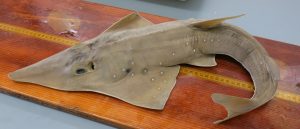Playing for Time
Guitarfish and Wedgefish – is this the last dance?
Funded by the Save Our Seas Foundation, this project aims to 1) clarify the taxonomic status; 2) biogeography; and 3) fisheries status of western Indian Ocean guitar- and wedgefishes, in order to provide improved species-specific identification for fisheries data collection for developing and implementing better conservation strategies and fisheries management policy, e.g. compliment NPOAs.
Recent studies have pointed to the concern that batoids in general, and more specifically those of the order Rhinopristiformes, are among the most endangered Chondrichthyan species globally. One family, the sawfishes (Pristidae), is among the most critically endangered groups, with all species having been extirpated from much of their range. While steps have been taken to address concerns over these charismatic shark-like rays, three families with this order (Glaucostegidae, Rhinidae, Rhinobatidae) exhibit similar life history and habitat characteristics that make them exceptionally vulnerable to overexploitation, leading to extirpation and possible extinction. In addition to the highly sought after flesh for human consumption, the fins are of extremely high value in the shark-fin trade, with fin prices for the larger species bringing significantly higher value than the meat. The challenges facing these shark-like rays, includes misidentification, incomplete biogeography, fisheries data, and political will to implement conservation and fisheries management policies.

The Western Indian Ocean (WIO) holds one of the most diverse Chondrichthyan fauna’s globally with >300 species, and with 19 new species described since 2016; this represents ~30% of all new species named during this period. The region also has a high degree of endemism, with 60+ species, many of which have very restricted geographic ranges. The number of new WIO species being discovered does not appear to show any signs of slowing, with additional new species currently under investigation. Five of the top 26 major fishing countries for Chondrichthyans are located in the WIO, but species-specific landing data for most species is unavailable. This is due to a combination of many species being inadequately described, a lack of well defined external characteristics for identification, and poorly defined biogeographic ranges. In addition, there is a lack of identification guides for field observers monitoring and recording coastal Chondrichthyan landings. The lack of species-specific information has lead to concern over the population status of many species.
A recent review of the threat status of WIO Chondrichthyans found that slightly more than one-half (50.9%) of Arabian Sea and nearly 30% of southern African species were assessed as vulnerable or higher (Ebert & van Hees, 2015; Jabado et al., 2018). This includes several species not seen in decades that maybe extinct? The number of WIO threatened species is much higher than reported by Dulvy et al. (2014) who found slightly >17% of all species were assessed as vulnerable or higher. Of the taxa reviewed, Dulvy et al. (2014) determined the shark-like rays (Rhinopristiformes) were highly threatened; this included the guitarfish and wedgefish, the latter also referred to as violyn sharks. Reviewing the conservation status of WIO guitar- and violyn sharks for this proposal found that of the 23 species known to occur in the region 12 (>51%) are assessed as vulnerable or higher. This includes one and possibly two species not been seen since the 1920s, and may now being extinct. Six species are assessed as data deficient, four near threatened, one least concern, and one species has not been assessed. 15 species are endemic, with some as presently known having a very limited biogeographic range. A problem with monitoring and recording data for these shark-like fishes is a lack of external characteristics to identify individual species, and a lack of knowledge on the biogeographic range. For example, during recent field surveys by PI Ebert two new species were identified, two species not seen in over a decade were found, and the distribution of several species extended. In addition, two new species have been described in the past two years. These findings highlight the lack of basic taxonomic and biogeographic information for the WIO. The closely related sawfishes have disappeared from large areas they once inhabited with relatively little notice, and despite recent conservation measures it may just be too late to ever reestablish these iconic rays to their former range given the slow call to action. Similarly, unless immediate action is taken the same fate may await the guitar- and violyn sharks as they play for time and we ask ourselves “Is this the last dance for these sharks?”

